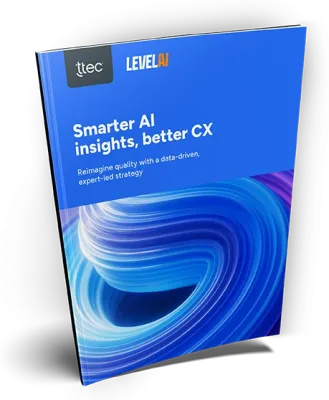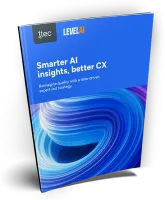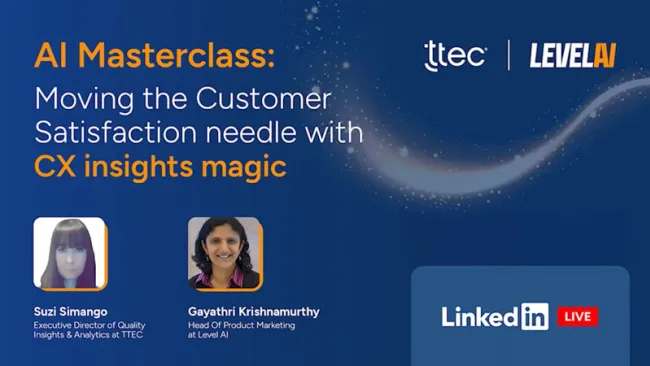Some say the contact center industry is “prehistoric.” It’s not innovative. It’s part of a bygone era. So then why are some of the biggest names in Big Tech jumping into the mix with their own contact center platforms? Because they know what we at TTEC have been touting for years – innovations in customer experience can yield tremendous financial upside and strong customer loyalty.
The contact-center-as-a-service (CCaaS) space is red hot right now. According to Straits Research, the cloud contact center market is projected to reach $82 billion by 2030, with a CAGR of 21.3%. A mix of new and established players want to take customer experience to the next level—in the cloud, with non-voice channels at the forefront. The contact center industry represents a massive addressable market and growth opportunity for cloud services, with the winner most likely being deemed "King of the Cloud."
Take Google, for example. Back in March the company announced the expansion of its Google Contact Center AI tools to become a standalone, cloud-based platform (CCAIP). Widespread rollout commenced this Fall—with TTEC as a leading systems integration partner.
Google’s investment in an end-to-end contact center platform joins the ranks of Microsoft, Amazon, and other “hyperscaler” companies outside the contact center space who have their own versions of cloud contact center solutions (and who are also TTEC partners).
The old world meets the new
What is it about the contact center space, considered awash in “old tech,” that has caught the eye of tech giants? The answer lies in the core functions of many of these firms—using AI, data analytics, collaboration, and a central knowledgebase to run business better and more efficiently.
With advancements in unstructured data analysis and more connected devices sourcing more data, insight from customer behavior, sentiment, demographics, voice-of-the-customer, product history, and other data is getting more robust and actionable. Employee data is also growing exponentially to inform workforce management, QA, and efficiency improvements as well. The processing and analysis of that data will encourage companies to centralize other marketing- and customer-related data into a single place—the cloud—creating an opening for high-tech companies to show off their strengths in data management, AI, and other leading-edge technology. The cloud can serve as the single source of CX truth.
A cloud platform allows these firms to easily connect to complementary services. If a company is running its contact center platform in AWS / Google / Azure, it will logically want to run other CX-related applications in the same cloud. Microsoft, for example, tapped into its Teams and Office 365 tools to create a closed-loop platform for contact center operations, collaboration, data, and insight with its Microsoft Digital Contact Center Platform. It simply applied a new use case to tools that have already proven their scalability and credibility in the enterprise. In its case, the data can be more easily integrated and infrastructure costs are kept low with everything running on a single cloud platform.
AI drives digital transformation in the contact center
Digital transformation initiatives over the last several years have CX leaders looking for ways to leverage AI and automation to gain efficiencies within their labor forces, while looking to cloud-native applications to bring down their annual technology spend. The hidden cost behind both labor and technology is the initial cost to stand up a new solution, plus the ongoing administration and maintenance of the technology. Cloud systems ease both of these burdens.
Google started out with AI tools to support third-party CCaaS platforms, but the company decided to go all-in on the entire end-to-end contact center platform to meet this need and consolidate data for easy access to other Google tools. Google AI, for example, is considered best in class, supporting the largest language translation library and broadest set of AI development tools.
In addition to its own tools, Google emphasizes digital channel delivery, mobile experience, and easy integration with CRMs and other systems brands already have in place to support customer interactions and improve employee productivity. It has taken an "out of the box" go-to-market approach, by including native features like CCAI for virtual agents, a mobile software development kit (SDK), a Web SDK, as well as connectors for all the major CRMs.
On the analytics side, brands can easily access Google’s conversational analytics, intent, and sentiment analysis tools. And in Google’s case, digital experiences are not a premium, they’re business as usual. Access to chat, SMS, and social channels is available out of the box. Expect to see this model to grow among contact center technology providers as the non-voice share of customer increases within the contact center industry.
Reimagining the contact center
Tech companies provide a new perspective of what “contact center platform” means. They are learning how customers want to behave and changing to serve those needs while achieving economies of scale.
In Amazon’s case, the company decided to build its own internal customer service platform to adhere to its “customer obsession” leadership principle. The on-premise options available at the time didn’t meet its expectations for speed, scale, cost, flexibility, and reliability. The internal product was the foundation of what would become Amazon Connect. The same Natural Language Understanding (NLU) engine that powers Alexa was applied for conversational IVR and its flexible nature is attractive to brands that prize speed, agility, and innovation. Brands can swap out services and tools easily in a pay-as-you-go model compared to a traditional contact center technology and cost structure.
All of these hyperscaler brands are helping reshape the industry to consider user experience (UX) and customer experience (CX) ahead of legacy product features and systems. By consolidating CX data and providing cloud-first technologies, brands can provide a more personalized, predictable customer journey. This injection of Big Tech into the traditional call center space has the potential to bring down product costs and allow brands to deliver new experiences and relevant products to market faster. End-user customers will ultimately benefit with simplified, faster, more personalized interactions in their preferred channels.
Combined with the best humans to bring out the potential of the technology, we are excited to see how the industry continues to innovate, with seasoned experts as well as fresh ideas from outside the industry to deliver amazing customer experiences.
High-tech goes all-in on contact center cloud
Why tech innovators are embracing what’s considered to be an old-school industry















